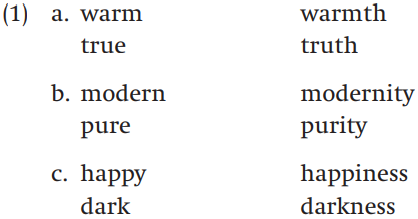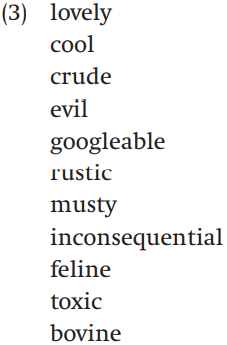


 Grammar
Grammar
 Tenses
Tenses
 Present
Present
 Past
Past
 Future
Future
 Parts Of Speech
Parts Of Speech
 Nouns
Nouns
 Verbs
Verbs
 Adverbs
Adverbs
 Adjectives
Adjectives
 Pronouns
Pronouns
 Pre Position
Pre Position
 Preposition by function
Preposition by function 
 Preposition by construction
Preposition by construction
 Conjunctions
Conjunctions
 Interjections
Interjections
 Grammar Rules
Grammar Rules
 Linguistics
Linguistics
 Semantics
Semantics
 Pragmatics
Pragmatics
 Reading Comprehension
Reading Comprehension|
Read More
Date: 2024-02-05
Date: 2024-02-06
Date: 2023-10-30
|
Productivity and creativity
Introduction:
Consider the examples in (1):

In each case, we have adjectives and nouns that are derived from them (all cases of transposition, by the way). As a first pass, we might hypothesize the three rules of lexeme formation in (2):

Now consider the list of adjectives in (3). If you had to make a noun from each of these, which of the three suffixes would you choose (note that you might be able to use more than one in some cases)?

Chances are that there are some of these words that you would choose to use -ity with (I choose crude, toxic, googleable, rustic, inconsequential, maybe feline), and others that you would use -ness with (for me, lovely, cool, evil, musty, probably bovine). Your choices might be slightly different from mine, but I’d be willing to predict that you didn’t choose to use -th with any of these adjectives.
What does this mean? In some cases, we can look at words, decide that they are complex, and isolate particular affixes. But when it comes to using those affixes to create new lexemes, we have the sense that they are no longer part of our active repertoire for forming new words. We have no trouble using other affixes, however, even if we’ve never seen them on particular bases; for example, you may never have seen a noun form of the word bovine, but you have no trouble forming the word bovineness (or maybe bovinity, or maybe even both). Processes of lexeme formation that can be used by native speakers to form new lexemes are called productive. Those that can no longer be used by native speakers, are unproductive; so although we might recognize the -th in warmth as a suffix, we never make use of it in making new words. The suffixes -ity and -ness, on the other hand, can still be used, although perhaps not to the same degree. Most morphologists agree that productivity is not an all-or-nothing matter. Some processes of lexeme formation, like affixation of -th, are truly unproductive, but for those processes that are productive, we have the sense that some are more productive than others. In this chapter we will explore in some detail what we mean by productivity, and look at a number of factors that contribute to productivity. We will also look at several ways in which productivity can be measured.
|
|
|
|
علامات بسيطة في جسدك قد تنذر بمرض "قاتل"
|
|
|
|
|
|
|
أول صور ثلاثية الأبعاد للغدة الزعترية البشرية
|
|
|
|
|
|
|
مكتبة أمّ البنين النسويّة تصدر العدد 212 من مجلّة رياض الزهراء (عليها السلام)
|
|
|